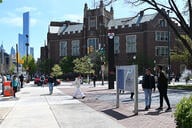You have /5 articles left.
Sign up for a free account or log in.
The rate at which borrowers of federal student loans default on their debt within two years after beginning repayment rose for the sixth consecutive year, reaching its highest level since 1995, according to data released Monday by the Education Department.
One in ten borrowers across the country, 475,000 people, who entered repayment during the fiscal year ending in September 2011 had defaulted by the following September, the data showed. That’s up from 9.1 percent of a similar cohort of borrowers last year.
Even more borrowers are struggling in delinquency when the period of measurement is extended to three years. The percentage of borrowers defaulting within three years after beginning repayment has also risen from 13.4 percent to 14.7 percent for the most recent cohort of borrowers available (those who entered repayment from October 1, 2009 to September 30, 2010 and had defaulted by September 2012). The 14.7 percent default rate represents 600,000 borrowers.
The default rate is used by the Education Department to potentially cut funding to institutions that have high large proportions of borrowers defaulting on their loans. Colleges are currently barred from receiving federal student aid money if their default rates are 25 percent or higher for three consecutive years or if they exceed 40 percent in a single year.
The Education Department is in the process of transitioning to using only the three-year default rates. Next year will be the first year for which institutions will face penalties based on their three-year rates, which student advocates say is a welcome change since the measurement will be more expansive. Still, though, some argue that the cohort default rates don’t reflect the full burden of debt that students borrow.
“Even at schools where lots of students borrow, [default rates] don’t tell you how many students are behind on payments, overloaded with debt or defaulting after more than three years,” Debbie Cochrane, research director at The Institute for College Access & Success, known as TICAS, said in a statement. TICAS has also issued reports about how colleges are manipulating their default rates to be lower than they actually are by combining programs or pushing students into unnecessary forbearances.
Differences Between Sectors
The average two-year default rate for all public institutions was 9.6 percent, compared with 5.2 percent for all private institutions. For-profit institutions as a sector had an average two-year default rate of 13.6 percent. But at 15 percent, community colleges appeared to have the highest two-year default rate of any type of institution.
Justin Draeger, president of the National Association of Student Financial Aid Administrators, said that the community college rate reflected significant problems with repayment rather than debt loads, since community colleges tend to be less expensive and have lower rates of loan borrowing.
“Given that 15 out of 100 borrowers (who presumably have small cumulative loan amounts) from the community colleges are defaulting, I think the data continues to tell us that we have a repayment crisis, not a student debt crisis,” Draeger said in an e-mail. “Borrowers have many ways of avoiding default; we have a lot of work to help them to those alternatives.”
As a result of the data released this year, eight institutions are now face sanctions for having default rates that are too high. That’s the highest number of institutions since 1998.
The affected schools are: John Wesley International Barber & Beauty College in Long Beach, Calif.; Pacific Coast Trade School, in Oxnard, Calif.; Palladium Technical Academy, in El Monte, Calif.; New Age Training, in New York City; Huntington School of Beauty Culture, in Huntington, W.V; Tidewater Tech in Norfolk, Va.; Florida Barber Academy, in Pompano Beach, Fla., and Henri’s School of Hair Design, in Fitchburg, Mass.




